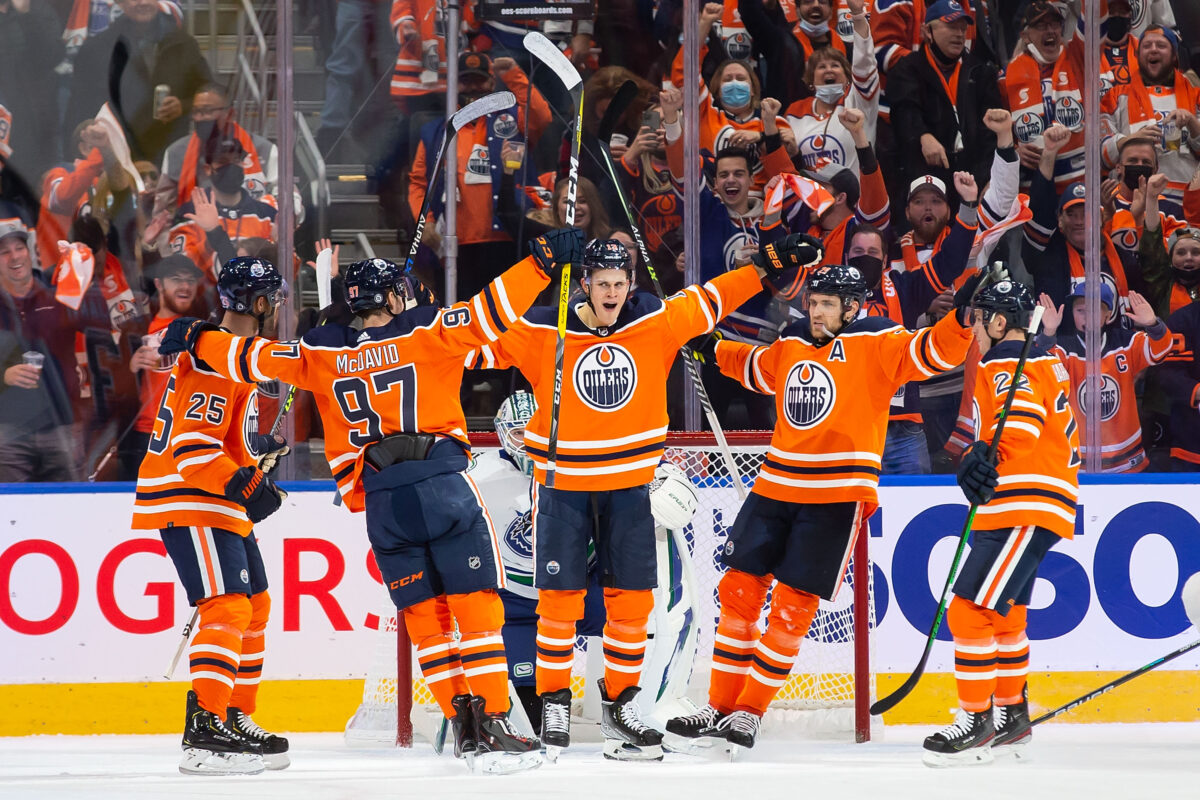There is little to feel good about right now for a struggling Edmonton Oilers team that has just two wins in its last 13 games while plummeting from first to 10th in the Western Conference. After returning last week from a five-game road trip that produced zero wins and two points, the Oilers have been stuck on the sidelines, thanks to a series of postponed games that will keep Edmonton from playing until at least Saturday (Jan. 15) when the Ottawa Senators are scheduled to visit Rogers Place.

But there is one positive development with the Oilers, who in their last seven games have scored as many goals as they’ve allowed (17) at 5-on-5 — a massive improvement from Edmonton’s first 27 games of the season during which the Oilers were outscored 63-51 at 5-on-5.
What particularly makes these numbers notable is how they compare to those of Edmonton’s most successful stretch of hockey in many years. During their incredible 16-5-0 start that vaulted the Oilers to the top of the conference standings, they actually were outscored at 5-on-5, 48-46.
Better Defensive Play
It’s all the little things that have added up to better Edmonton’s goal differential at 5-on-5 from minus-0.44 in the season’s first 27 games to 0.00 the past seven.
Comparing 5-on-5 percentages per 60 minutes over those two spans, data from Natural Stat Trick shows that Edmonton’s share of total shots has jumped from 48.17 percent to 53.83 percent, scoring chances has moved up from 48.49 percent to 52.70 percent, and high-danger chances has gone from 47.19 percent to 49.15 percent.
The biggest strides at 5-on-5 have come in Edmonton’s own end, where the Oilers are giving up 4.4 fewer shots per 60 minutes (28.17 down from 32.57), which has led to 3.57 fewer scoring chances against (24.84 down from 28.33). They’ve dramatically improved their high-danger chances against at 5-on-5, which for the first two months of the season had consistently ranked among the worst in the league, at well over 12 per 60 minutes, to below 10 per 60 minutes over the last several games. The overall result? Edmonton is conceding nearly 0.5 goals per 60 minutes at 5-on-5, from 2.9 in the first 27 games to 2.43 since.
Kailer Yamamoto, whose two-way play at even strength this season has perhaps flown under the radar, led the Oilers in 5-on-5 points, with two goals and three assists, on Edmonton’s latest 5 games, a road trip spanning Dec. 29 to Jan. 5. Leading scorers Leon Draisaitl and Connor McDavid were second with four points apiece over the five-game trip.
Special Teams Are Struggling
The difference between wins and losses earlier this season came on special teams. For much of the schedule’s first six weeks, Edmonton ranked first or second in the NHL in both power play and penalty kill percentage.
Related: Oilers’ Dominant Penalty Kill Flying Under the Radar
Through 21 games, when Edmonton went 16-5-0, the Oilers’ power play was clicking at 35.9 percent and their penalty kill had an 87.7 percent success rate. Over the 13 games since, as Edmonton has gone 2-9-2, its power play is 18.8 percent and the penalty kill is an atrocious 68.4 percent.
Edmonton’s net goals differential on special teams (including shorthanded goals for and against) was plus-18 over the first 21 games, but minus-six over the last 13. On its latest road trip, the team killed off just 10 of 15 power plays, and had only five power-play opportunities, failing to score on any of them.
5-on-5 Play Crucial Over the Long Term
Edmonton’s special team’s downturn is a huge negative that has more than offset the positive developments at 5-on-5, and a big reason why they have only two wins since Dec. 1.
But the majority of each NHL game is played at 5-on-5, especially in the postseason when officials are notorious for putting their whistles away; teams that are overly reliant on the man advantage to produce goals don’t often hoist the Stanley Cup. Playing sound, smart hockey at even strength is imperative if the Oilers plan on making any kind of a run this spring.
Further, there is every reason to believe Edmonton’s performance on special teams will return to fine form. Over the course of coach Dave Tippett’s two-plus seasons in Edmonton, the Oilers have thrived when the ice is tilted: Edmonton had the NHL’s top-ranked power play in both 2019-20 and 2020-21, while its penalty kill ranked second in 2019-20 and ninth last season.
What the Oilers haven’t yet shown for any sustained period under Tippett is the ability to control play when the sides are even. Edmonton’s goal differential at 5-on-5 has been negative in all three of the coach’s seasons: minus-10 in 2019-20, minus-one in 2020-21, and now minus-12 through 34 games this season. If Edmonton can continue this positive trend at 5-on-5 and return to its usual high standard of special teams play, the next 13 games could see the team go 9-2-2 just as easily as they’ve gone 2-9-2 in the last 13.

